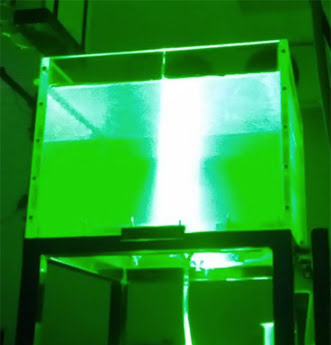LIVERPOOL, UK, May 18, 2015 — A better understanding of volcanoes' inner workings based on fluorescence imaging could help save lives.
A team from the University of Liverpool in the UK, Monash University in Melbourne, Australia, and the University of Newcastle in Callaghan, Australia, has developed a technique that could enable faster and more accurate detection of volcanic unrest.
"Understanding the triggers for volcanic eruptions is vital for forecasting efforts, hazard assessment and risk mitigation," said Janine Kavanagh, a lecturer at the University of Liverpool's School of Environmental Sciences. "With more than 600 million people worldwide living near a volcano at risk of eruptive activity, it is more important than ever that our understanding of these complex systems and their triggering mechanisms is improved."

A frequency-doubled Nd:YAG laser sheet illuminates fluorescent particles in gelatine, allowing researchers to simulate magma movement within a volcano. Courtesy of Janine Kavanagh/University of Liverpool.
The researchers created scale models in the lab at Monash University, allowing them to study volcano plumbing systems by demonstrating how magma ascends from great depths up to the surface through a series of connected fractures (dykes and sills). Colored water was injected into a tank filled with gelatine (jelly) to mimic rising magma.
The researchers used a frequency-doubled Nd:YAG laser sheet (532 nm) to illuminate fluorescent particles in the gelatine, allowing them to track the simulated magma's movement. A CCD camera recorded images of the fluorescing particles with the same timing as the laser sheet, 2 Hz, for up to 60 minutes. A 532- to 546-nm bandpass filter was mounted on the camera to eliminate spurious reflections.
Sandy Cruden, professor at the Monash School of Earth, Atmosphere and Environment, said, “we discovered a significant and previously unknown drop in pressure when the ascending vertical dyke stalled to form a horizontal sill.” A pressure drop can drive the release of dissolved gasses, potentially causing the magma to explode and erupt, he said.
"It's similar to removing a cap from a bottle of shaken fizzy drink," he said. "The pressure drop causes bubbles to form, and the associated increase in volume results in a fountain of foam erupting from the bottle."
The technique essentially records when and how magma moves at depth and helps determine the likelihood of an eruption, whereas other volcano-monitoring systems rely on satellites, ground deformation devices and seismometers.
The research was published in Earth and Planetary Science Letters (doi: 10.1016/j.epsl.2015.03.038).
For more information, visit www.liv.ac.uk.